
|
|

|
|
A potential problem is that the Universe is inferred to be 13.7 billion years old based on observations of the Cosmic Microwave Background Radiation (CMBR) and our current best version of the Big Bang Theory . The ages of the oldest stars in our Galaxy (the Milky Way galaxy) are found from studies of: (i) globular cluster stars which are estimated to have ages to lie between 11 and 18 billion years with 95 % confidence that they must be older than ~11 billion years. If globular clusters are found to have ages closer to the upper end of their estimated ages, then significant alterations will need to be made to our current thoughts about the Universe. (ii) Cold white dwarfs also offer a way to determine the age of the Milky Way galaxy. Hansen et al. (2004) found that the ages of the oldest white dwarfs are 12.7 billion years with an uncertainty of 0.7 billion years. This, again, is younger than the age of the Universe, but the outer edge of the estimate does place the ages of the oldest white dwarfs near the age of the Universe which could be problematic as structure, such as stars, likely did not form that early.
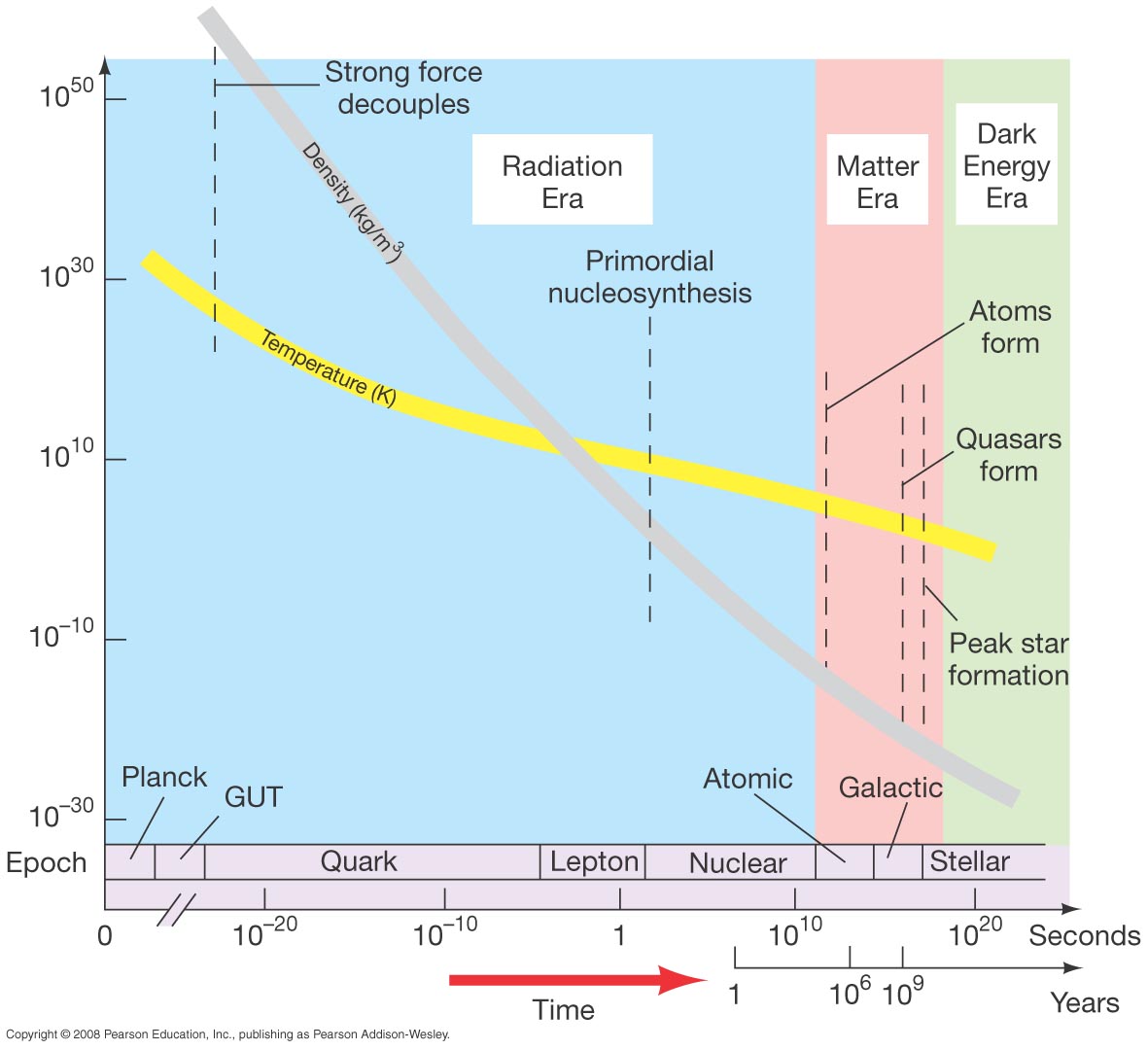 |
Timeline for the Universe: From Today to the BeginningToday, the Universe is bathed in the 2.7 Kelvin CMBR and we have estimates for the amounts of matter (normal and dark) and dark energy in our Universe. Consequently, given ideas about how the Universe evolves, we can determine what the Universe was like when it was younger (and smaller). If we were run the clock backward from today, we would find that the Universe was hotter and denser and we would encounter almost unimaginably extreme conditions at early times. We would find that at the earliest times in the Universe, the Universe was dominated by radiation. As the Universe expanded and cooled, eventually matter dominated the evolution of the Universe. The crossover occured around 50,000 years after the Big Bang. As the Universe continued to expand and cool, Dark Energy took over and dominated the evolution of the Universe. This crossover occured around 4 billion years ago. We are currently in the Dark Energy era. At early times, Dark Energy is less important than matter and radiation, in general, and so may be ignored in the discussion of the Early Universe. This statement carries a caveat, however, in that some repulsive force did act early in the evolution of the Universe during the Era of Inflation. In the sections below, we discuss the evolution of the Universe in more detail. |
The principal distinction between the models is the manner in which the Universe eventually winds-up its evolution. The early times are fairly similar. This simplifies our discussion. Before I continue, let me define some quantities which have appeared in some earlier plots, but which were not discussed in detail.
The ultimate fate of an expanding Universe is determined by the interplay of;
 |
The above two plots show the behavior of the Friedman models in two forms. The left figure shows how universes look in terms of how the redshifts of distant galaxies depend on their distances (this is the Hubble Law for small redshift, z). The right plot shows how the scale factor R(t) changes with time for the different universes.Initially, the Universe was driven to expand by some unknown impetus. The current rate at which the Universe expands is measured by the Hubble constant Ho. The expansion is slowed by the gravitational attraction of material contained in the Universe. If the amount of material is large enough then the expansion of the Universe will be halted and the Universe will eventually stop expanding and start to contract! In this sense, one can define an escape speed for the Universe. If the Universe exceeds this escape speed, it will expand forever.
|
The critical density is given by

where H (=Ho) is the Hubble constant and G is the gravitational constant. Note that the faster the expansion (the greater the Hubble constant Ho, the larger the critical density.) For the currently accepted Hubble constant value, Ho ~ 22 km per second per million light years, the critical density is around 9x10-30 grams per cubic centimeter. This critical density which controls the evolution of the Universe is very rarefied; the density of air in this room is around 10-6-10-5 grams per cubic centimeter.
We define the quantity known as Omega as


where the material density is composed of two parts, the matter density composed of the dark matter and normal matter, and the Dark Energy component. Here, the Omegas are the fractions of the critical density contained in the matter component and Dark Energy component, respectively. For an open universe, the measured density is less than the critical density and the sum of the Omegas is less than l and for a closed universe, the measured density is greater than the critical density and the Omegas are greater than 1.
|
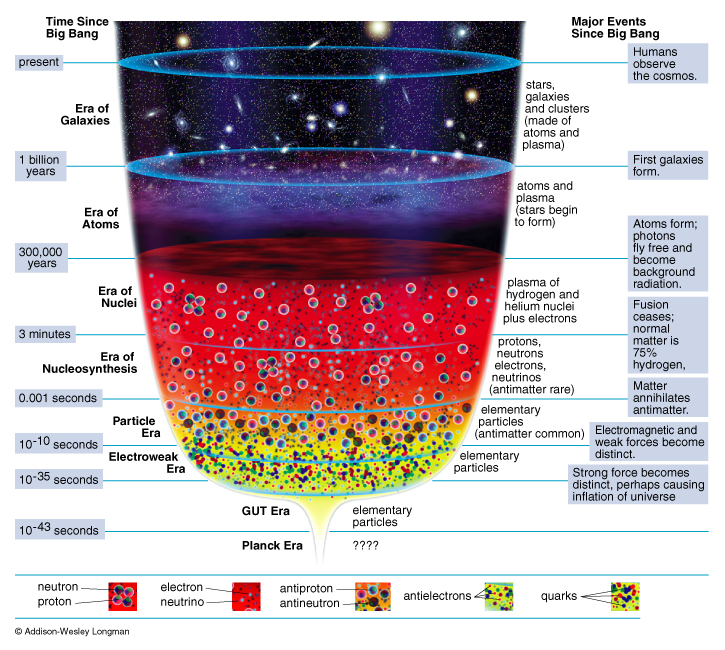
|
The Planck era when the four forces of the Universe -- the gravitational, electro-magnetic, strong (nuclear), and weak forces -- may have been unified. This is the era of quantum gravity -- the time when a theory which encompasses both quantum mechanics and gravity must be used. The size of the current Universe at this time is less than 10-50 centimeters.

|
Era of the Grand Unified Theories (GUTs) when gravity separates from the other three forces (i.e., gravity becomes an interaction distinct from the other forces). This ended after around 10-32 seconds had elapsed after the Big Bang. At this time the Universe had a temperature of 1027-1028 Kelvin. Inflation begins at the end of this stage -- inflation is driven by some as of now, unknown repulsive force. We describe inflation in the next section. |
The strong (nuclear) force becomes a distinct interaction at the beginning of this stage and inflation stops at the beginning of this stage. During inflation, the Universe increases in size by a huge factor -- perhaps by as much as a factor of 101012!!! Some models say that the size of the current Universe increased from 10-50 centimeters to roughly the size of a grapefruit during inflation. A region as small as the Planck length (~ 10-33 cm) would expand enough to encompass the currently observable Universe.
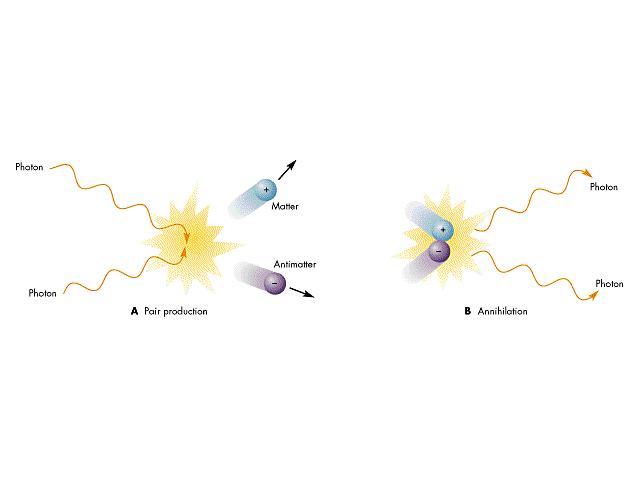
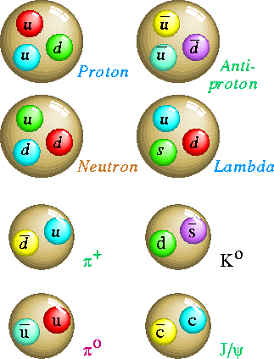 |
|
 |
After inflation the Universe is dominated by a quark-gluon plasma. What are quarks and gluons? To the right is a schematic picture of what is known as a baryon. Baryons are a class of fundamental particles which includes protons and neutrons; protons and neutrons are composed of three quarks held together by the intermediary particles known as gluons. When the Universe is very hot and energetic, the quarks and gluons are free and are not tied up in baryons. |
 |
Around 10-6 seconds after the birth of the Universe, quarks and gluons combine to form baryons (neutrons and protons). This marks the end to the Quark Epoch. The production of baryons continues until the temperature drops below 1013 Kelvin where the Universe is no longer energetic enough to produce baryonic matter/anti-matter pairs. Unfortunately, there is no barrier to annihilations of matter/anti-matter pairs and the annihilation process continues quite efficiently. As noted earlier, we are lucky in that there was a slight asymmetry between matter and anti-mattter quarks and leptons which allows some matter baryons to survive the annihilation! The production of the matter baryons is referred to as baryogenesis while the existence of the slight excess of matter over anti-matter referred to as the Matter-Anti-Matter Asymmetry Problem.
Because electrons are less massive than baryons, the similar event for electrons and their anti-matter twins, the positrons, occurs later, around ~1 second after the birth of the Universe when the temperature has dropped below 1 billion Kelvin.
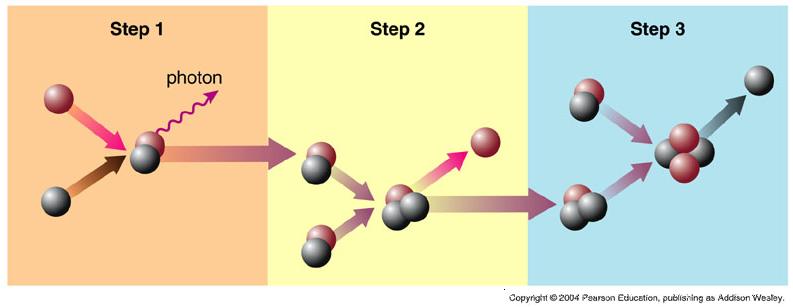 
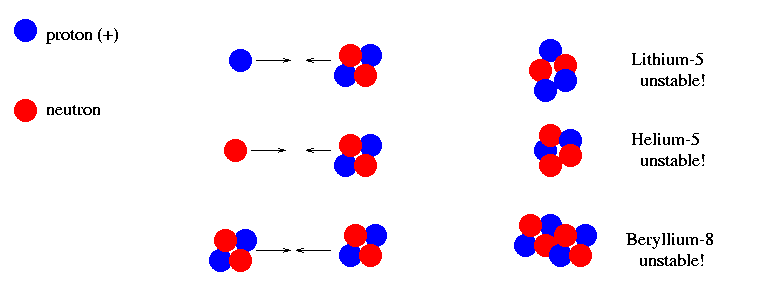
|
|
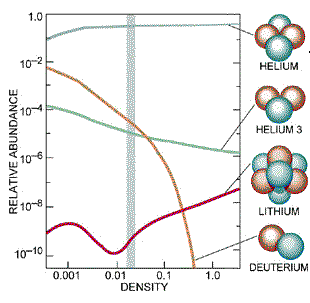 | In Big Bang Nucleosynthesis, only hydrogen, helium, lithium and the hydrogen isotope deuterium are produced in significant amounts (see the figure to the left). The amount of helium produced in the Big Bang is insensitive to the mass contained in baryons in the Universe, but the amount of deuterium is very sensitive to the mass in baryons in the Universe. Based on current measurements of the primordial abundances of hydrogen, helium, and deuterium, we infer that the amount of normal matter which can be contained in the Universe is 3-4 % of the critical density (the gray bar in the figure to the left)!After the finish of the era of nucleosynthesis, the Universe continues to expand and cool but no new chemical elements are created until stars form and die. |
The Universe becomes cool and rarefied enough for electrons and protons
to form neutral hydrogen atoms. This occurs around when the temperature of
the Universe has dropped to around 3,000 Kelvin (z ~ 1,100).
Currently,
the largest structures in the Universe are consistent with the
imperfections seen in the CMBR.
If we see much larger structures, then there will be trouble.
Quasars and some radio galaxies become detectable
Solar System, planets, life, ...

Hydrogen gas is not an
efficient absorber of light and so the Universe becomes transparent.
To understand look at the figure to the left which shows a
tube that contains hydrogen gas and the spectrum of the tube at the
lower right. An electric
current is run through the tube exciting the hydrogen atoms causing
them to radiate. Notice that the hydrogen atoms produce only certain colors
(wavelengths) of light. Absorption being the inverse of emission means that
the same hydrogen atoms will absorb only the same colors of light which it
emits. Most of the light impinging on hydrogen gas is unaffected by
the presence of the gas!
Before the Era of Recombination
, the Universe was
opaque to radiation, that is, the Universe was "foggy" in that
light could not travel very far which meant
that our view of the Universe was limited. After
Recombination, the Universe cleared up, it became transparent
and our view of the Universe was unimpeded.
What are the consequences of this?
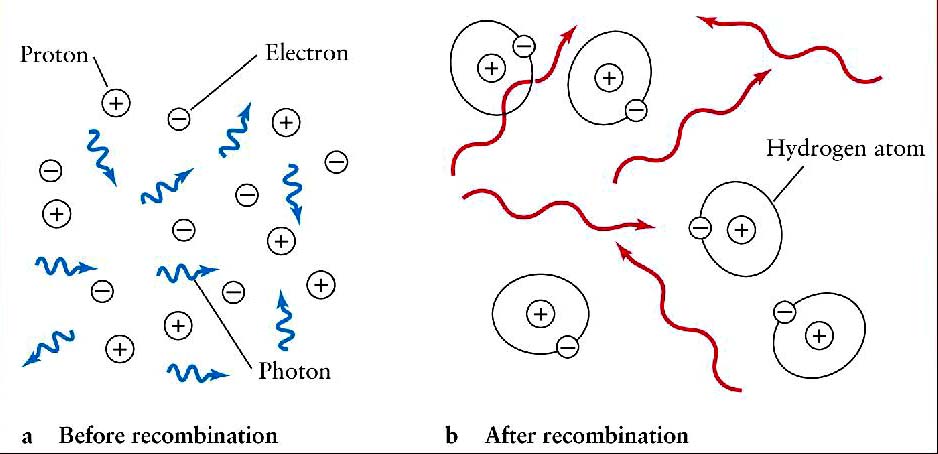
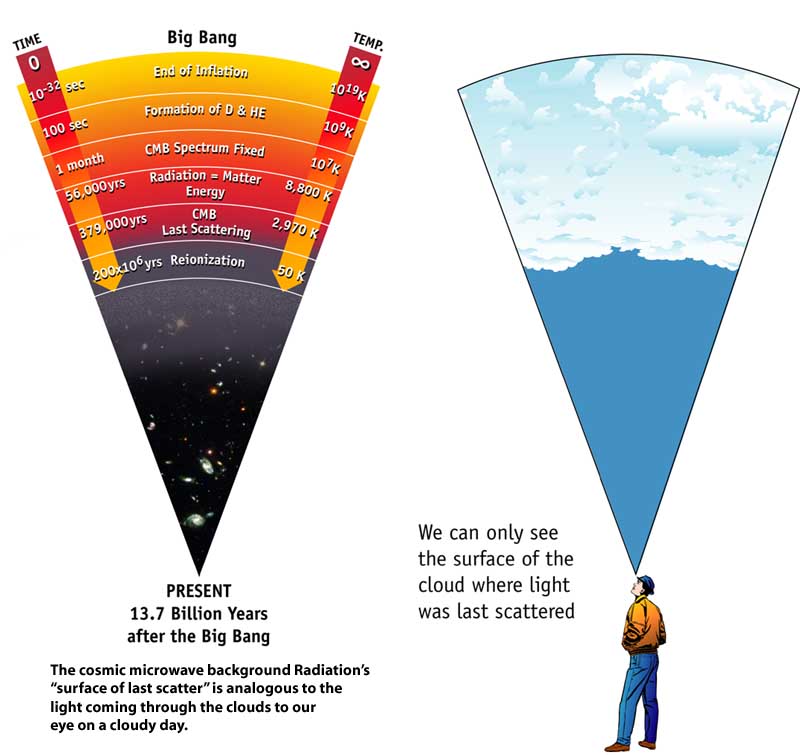
After
Recombination, we can get
unimpeded view of the distant Universe. So, as the Universe gets older,
we can see further and further into the past. However, we cannot see
forever because at some point the Universe becomes opaque; we can only see
up to Recombination, that is, we can see the
Universe as it was 378,000 years after the Big Bang.
This is what we see when we observe
the Cosmic Microwave Background Radiation, the CMBR.
This ia analogous to the situation we encounter when we see
the light from a cloud in the sky. We see the clear space between the
cloud and us, but we cannot see into the dense, opaque part of the cloud.

Protogalaxies begin to form. This may be annoying since
the clumps of matter and the
clumps of the clumps of overdense matter should distort the CMBR.
The reason is that if these clumps are formed by the attraction of
gravity, then such large overdensities take a fairly long time to form
(recall the discussion of the free-fall time).
If the Universe was only normal
matter, the observed variations in the CMBR are too small
to explain the observed structure in the Universe. We can reconcile this
problem by the existence of large amounts of Dark
Matter. Significantly, this allows the overdense regions to start
growing early in the evolution of the Universe; the origin of the
seeds which eventually lead to the current structure in the Universe have
their origins at Inflation.